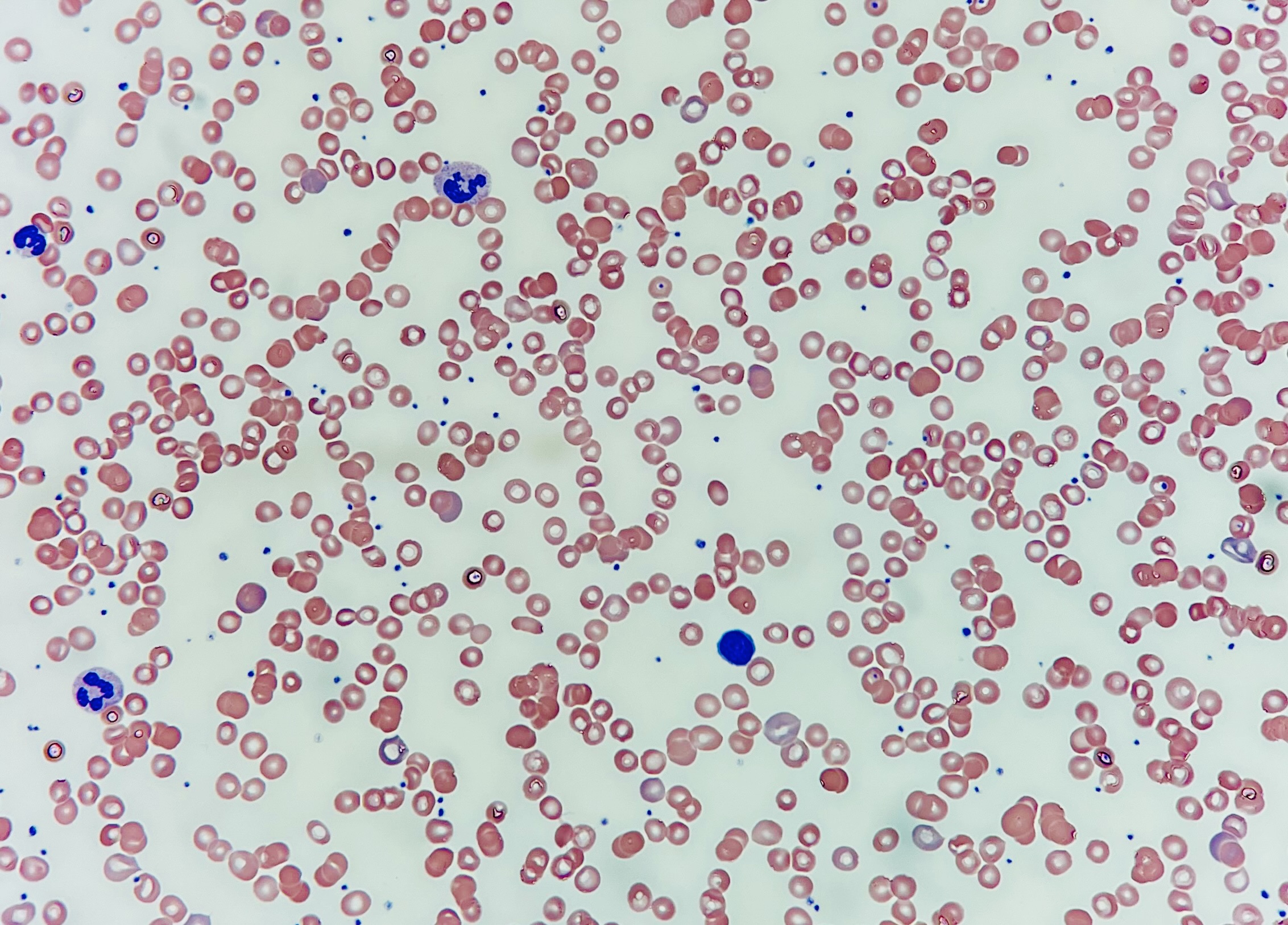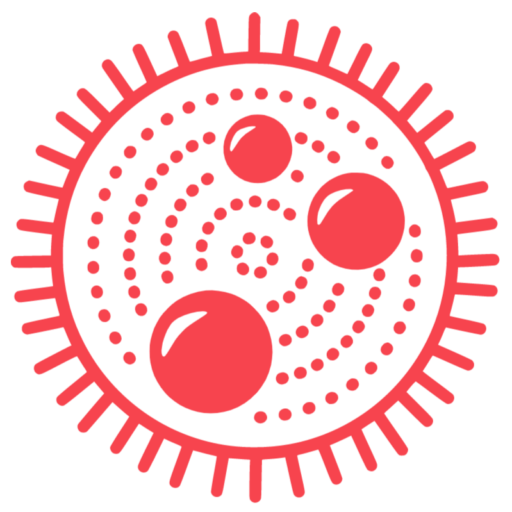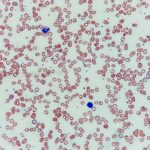
A peripheral blood smear is a key clinical tool used in the assessment of patients in hematology. It is an inexpensive and readily available test in most medical centers and laboratories. Smears can provide rapid information that can help guide our management decisions. Automated machines can provide relevant information usually reported in the differential of a complete blood count (CBC). However, machines may not note subtle findings and do not provide an interpretation if a certain finding is significant. Medical professionals particularly hematologists must become familiar with performing and interpreting peripheral blood smears.
How to Obtain a Peripheral Smear
Peripheral smears are predominantly obtained from peripheral veins. However, any blood source can be analyzed and may include central lines, arterial lines, and other methods. The blood sample is collected in an EDTA purple-top tube and then used for the preparation of the slides. It is crucial to use clean slides before obtaining the sample.
Equipment and Preparation
In general, a drop of non-clotted blood is used and placed on a slide for analysis. Having an appropriate technique will help obtain a good-quality smear and provide accurate information. Even though in most medical centers, laboratory personnel perform the preparation of a peripheral smear for review, medical professionals need to be aware of the necessary equipment and preparation of a smear for review. Here is a summary of the equipment and preparation of a peripheral blood smear.
- Gathering Materials: Materials can include clean glass slides, disposable gloves, alcohol swabs, lancets, and microscopic slides. A blood sample obtained from our patient will be used to be spread across a slide for analysis.
- Smear Preparation: Place a drop of blood close to one end (about 1 cm from the edge) with a pipette or capillary tube. Use another clean glass slide at a 30-45 degree angle to the first slide, touching the edge of the blood drop. Using a smooth and steady movement, spread the blood across the surface of the second slide to create a thin and even smear. Blood should extend to approximately 2/3 of the slide’s length. Please, watch the following video by Robert Bounds.
- Drying and Fixation: Allow the smear to air dry at room temperature to help avoid any possible artifacts that could form.
- Staining: Several stains can be used during the visualization of a peripheral smear such as a Wright-Giemsa or May-Grünwald-Giemsa. An optional step is to fix the smear by using a solution such as methanol for 1-2 minutes. Fixation helps preserve cell morphology and prevents cellular distortion.
- Mounting and Cover Slipping: After staining the smear, one could rinse the slide with distilled water to remove excess stain. A mounting medium could be applied to enhance the clarity of the cells and preserve them.
- Labeling and Storage: Make sure to appropriately label the prepared slide with the patient’s identification information, specimen source, and any pertinent clinical data. Store the slides in a slide box or rack to protect them from damage and contamination. Most of the time, clinicians interpreting a peripheral smear would get a slide that has been already prepared by laboratory personnel).
Interpretation and Analysis of a Peripheral Blood Smear
Once a smear is produced, it can be visualized under a microscope or uploaded into a digital microscope for virtual analysis. There are many software applications available at certain medical centers in which accessing a peripheral smear remotely is possible and can be quite convenient. However, it is important to become familiar with these applications and learn the limitations that they may have. For example, certain applications may not allow visualization of the entire peripheral smear and could lead to missing important findings. However, they are excellent tools that are convenient and helpful in patient care.
Systematic Evaluation
Begin by systematically scanning the entire smear at low magnification to assess the overall cellularity, distribution, and quality of the smear. A recommendation is to choose a particular method to review a smear and use it when interpreting any blood smear. For example, one can choose to scan a peripheral smear from one corner (e.g. top left) and move the slide down to the bottom (e.g. bottom left) vertically. Once that vertical stripe has been reviewed, move horizontally to the next one (e.g. to the right) and repeat the process until the entire slide has been analyzed. Some large cells or elements in a smear could accumulate mostly at the borders of a slide. For example, a blast may be seen close to the border or thick area and not in the thin area of a smear. Any systemic evaluation technique could be considered, understanding that a standard technique will help us not to miss findings in particular areas of a slide.
Here is a summary of the main blood smear elements that can be analyzed:
Red Blood Cells (RBCs)

Red blood cells are the predominant cells seen in a peripheral smear in normal conditions. Here is a table that summarizes the main characteristics of a normal red blood cell:
| Characteristic | Description |
|---|---|
| Shape | Biconcave and discoid |
| Size (Diameter) | 6 to 8 micrometers (µm) Can compare to the size of the nucleus of a small normal lymphocyte |
| Color | Pale pink to red |
| Central Pallor | Present, lighter area in the center |
| Uniformity | Minimal variation in size, shape, and color |
| Flexibility | High flexibility and deformability |
| Lifespan | Approximately 120 days |
Multiple RBC abnormalities could be observed in a peripheral smear and can point toward certain conditions that could be present. Here is a summary of the main RBC findings that could be detected:
| Abnormality | Description | Associated Conditions |
|---|---|---|
| Anisocytosis | Variation in RBC size (when comparing one to another) | Nutritional anemias, hemolysis (due to larger erythrocytes) |
| Poikilocytosis | Variation in RBC shape (e.g., presence of spherocytes, schistocytes) | Hemolytic anemias, hereditary spherocytosis, thrombotic microangiopathies (TMA) |
| Hypochromia | Decreased hemoglobin concentration, resulting in increased central pallor | Iron deficiency anemia, thalassemia, sideroblastic anemia |
| Polychromasia | Increased central staining due to the presence of residual RNA | Reticulocytosis, hemolytic anemias, bone marrow recovery |
| Spherocytosis | Presence of spherical or hyperchromic RBCs | Hereditary spherocytosis, autoimmune hemolytic anemia |
| Elliptocytosis | Presence of elliptical or oval-shaped RBCs, indicative of membrane abnormalities | Hereditary elliptocytosis, hereditary ovalocytosis |
| Target Cells (Codocytes) | RBCs with a central area of hemoglobin surrounded by a ring of pallor | Liver disease, thalassemia, hemoglobinopathies |
| Stomatocytes | RBCs with a central slit or mouth-like appearance | Liver disease, hereditary stomatocytosis |
| Spur cells (Acanthocytes) | RBCs with irregularly spaced, blunt projections on the cell surface (spurs) | Abetalipoproteinemia, liver disease, abnormally high cholesterol levels |
| Burr Cells (Echinocytes) | RBCs with evenly spaced, short, blunt projections (wheel-shaped) | Uremia, liver disease, pyruvate kinase deficiency |
| Tear-drop Cells (Dacrocytes) | RBCs with a teardrop-shaped morphology, often seen in myelofibrosis or bone marrow infiltration (think of cells squeezing out of the marrow) | Myelofibrosis, myelodysplastic syndromes, leukemias |
| Rouleaux Formation | Abnormal stacking of RBCs, resembling a stack of coins, indicative of increased plasma proteins | Multiple myeloma, Waldenström macroglobulinemia |
| Agglutination | Clumping of RBCs due to the presence of immunoglobulins or complement proteins | Autoimmune hemolytic anemia, cold agglutinins, transfusion reaction |
| Schistocytes (fragmented or helmet cells) | Presence of fragmented or fragmented RBCs, indicative of mechanical damage (sliced RBCs) | Disseminated intravascular coagulation (DIC), thrombotic thrombocytopenic purpura (TTP), hemolytic uremic syndrome (HUS) |
| Heinz Bodies | Round or irregular inclusions within RBCs composed of denatured hemoglobin | G6PD deficiency, thalassemia, exposure to oxidizing agents |
| Howell-Jolly Bodies | Small, basophilic nuclear remnants within RBCs | Asplenia, functional hyposplenism, megaloblastic anemia |

White Blood Cells (WBCs)
White blood cell abnormalities are important and can be diverse as well. Normal characteristics of white blood cells include:
| White Blood Cell Type | Size (Diameter) | Nucleus | Cytoplasm | Cytoplasmic Granules |
|---|---|---|---|---|
| Neutrophils | 10-12 µm | Multilobed, segmented nucleus (3-5) | Pale pink to light purple, fine granules | Present, primarily lysosomes |
| Lymphocytes | 6-9 µm | Round or slightly indented nucleus | Scant, blue-gray cytoplasm | Absent |
| Monocytes | 12-20 µm | Kidney-shaped or folded nucleus | Abundant, blue-gray cytoplasm | Present, fine, or vacuolated |
| Eosinophils | 12-17 µm | Bilobed nucleus | Bright red to orange-red granules | Present, large specific granules |
| Basophils | 10-14 µm | S-shaped or lobulated nucleus | Deep purple to black granules | Present, large specific granules |

WBC abnormalities that can be detected in a peripheral smear include:
| Abnormality | Description | Associated Conditions |
|---|---|---|
| Toxic Granulations | Increased cytoplasmic granules and staining intensity in neutrophils | Bacterial infections |
| Döhle Bodies | Blue-gray cytoplasmic inclusions in neutrophils | Infections, inflammatory conditions |
| Pelger-Huët Anomaly | Bilobed or hypolobulated neutrophil nuclei | Inherited abnormality, myelodysplastic syndromes |
| Hypersegmentation | Presence of neutrophils with more than five lobes | Megaloblastic anemia, vitamin B12, or folate deficiency |
| Atypical Lymphocytes | Enlarged lymphocytes with irregular nuclear contours | Viral infections, infectious mononucleosis |
| Smudge Cells (Basket Cells) | Fragile lymphocytes that rupture during smear preparation “smudged” | Chronic lymphocytic leukemia (CLL) |
| Dysmorphic PMNs | Usually irregularly shaped nuclei, cytoplasmic vacuolization, or nuclear hypo or hypersegmentation | Sepsis, severe infections, myelodysplastic syndromes |
| Clover Cells (flower cells) | Abnormal red blood cells with a tetra-lobed or cloverleaf-shaped appearance | Adult T-cell Leukemia/Lymphoma |
| Auer Rods | Cytoplasmic inclusions in myeloid blasts, rod-shaped structures | Acute promyelocytic leukemia (APML) and amyeloid leukemias (AML) |
| Reed-Sternberg Cells (owl’s eye) | Large, binucleated, or multinucleated cells with prominent nucleoli | Hodgkin lymphoma |
| Hairy Cells | Small lymphoid cells with “hairy” projections on their surface | Hairy cell leukemia |
| Plasma Cells (clock-faced cells) | Mature B lymphocytes with eccentric nuclei and abundant, deeply basophilic cytoplasm | Multiple myeloma, Waldenström macroglobulinemia |
| Blasts | Large cells with high nuclear-to-cytoplasmic ratio (big nuclei), prominent nucleoli, fine “open” chromatin (ready to proliferate) | Acute leukemias, myelodysplastic syndromes, myelofibrosis |
| Hypogranular Neutrophils | Neutrophils with decreased or absent cytoplasmic granules | Myelodysplastic syndromes (MDS), drug toxicities, congenital disorders affecting granulopoiesis |
| Hypoplastic Neutrophils | Neutrophils with reduced cytoplasmic volume or overall cell size | Aplastic anemia, chemotherapy-induced bone marrow suppression, viral infections |
We will include images and cases of the different WBC morphology changes in future posts and the Q-Bank sections that will describe these findings in more detail.
Platelets
Platelets are small cell fragments that can also be evaluated in a peripheral smear. Here are the normal characteristics of platelets:
| Characteristic | Description |
|---|---|
| Size | 2-4 µm in diameter |
| Shape | Discoid or oval |
| Cytoplasm | Pale blue, containing granules |
| Granules | Alpha granules (containing proteins involved in clotting), dense granules (containing ADP and serotonin) |
| Distribution | Evenly distributed throughout the blood smear |
One can observe several abnormalities in a peripheral smear that can help formulate a differential diagnosis or understand the overall clinical picture of a patient’s presentation including:
| Abnormality | Description | Associated Conditions |
|---|---|---|
| Thrombocytopenia | Decreased platelet count (decreased overall quantity per field) | Many causes including inflammation, infection, idiopathic thrombocytopenic purpura (ITP), leukemias, medication-induced, and many others |
| Thrombocytosis | Increased platelet count | Essential thrombocythemia, reactive thrombocytosis (e.g., following surgery or trauma) |
| Giant Platelets | Abnormally large platelets (larger than surrounding RBCs) | Bernard-Soulier syndrome, May-Hegglin anomaly, ITP, and other conditions with increased platelet production |
| Platelet Clumps (pseudothrombocytopenia) | Aggregates of platelets leading to clumps or clusters | Artefactual phenomenon, often seen in EDTA-anticoagulated blood (resolves when testing in citrate tubes) |
| Platelet Satellitism | Platelets adhering to the surface of neutrophils or other cells | Artefactual phenomenon, often seen in EDTA-anticoagulated blood |
Becoming familiar with the interpretation of peripheral smears is a great skill to develop and can help provide crucial information to guide our management decisions in hematology. It is challenging to learn all about peripheral smears in one post. However, we hope the current post serves as a starting point and a guide when evaluating smears in the future. Our website includes a peripheral smear section in the main menu area where you can find cases to review and continue practicing your skills. As with any other area in life, when it comes to peripheral smears, “practice makes perfect.” Maybe not perfect, but our best selves in the interest of our patients.
Although practice doesn’t ever make “perfect,” it almost always makes “better.”
Dale S. Wright







Thebl information was really helpful